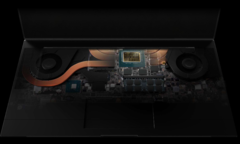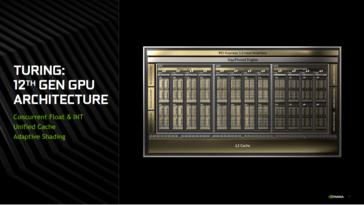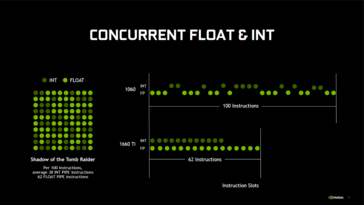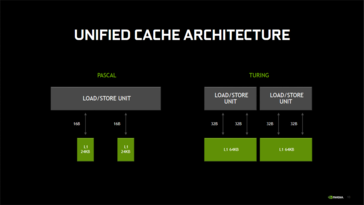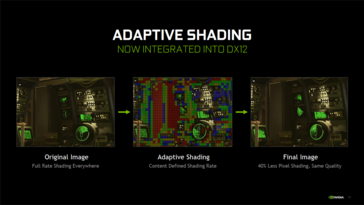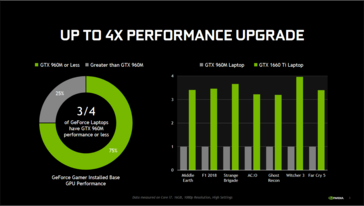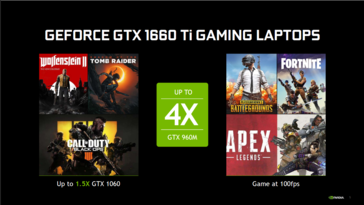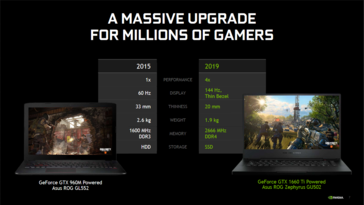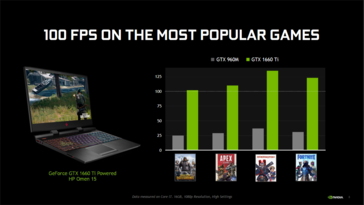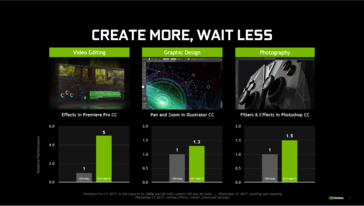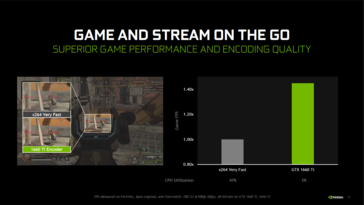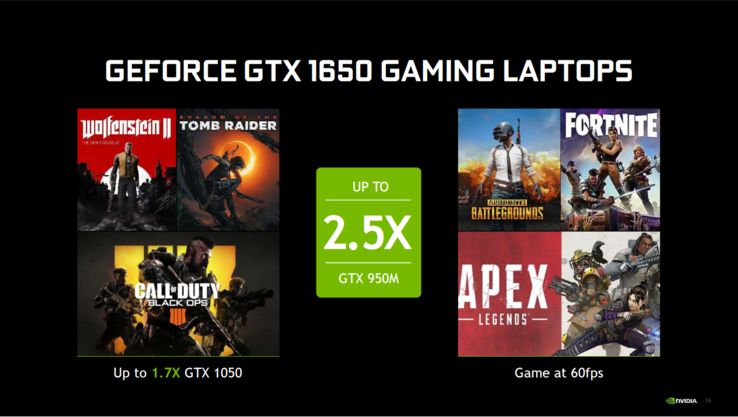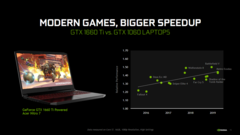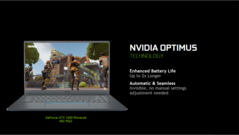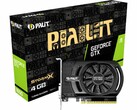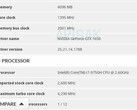We've been expecting NVIDIA to announce the mobile versions of the Turing-based GTX 1650 and the GTX 1660 Ti as successors to the Pascal-based mobile GTX 1050 Ti and the GTX 1070, and here they are finally. The new GTX 16-series does not sport fancy ray-tracing or Tensor cores but aim to offer considerable performance boosts for those who prefer a relatively affordable option for mobile gaming. We also have the first 3D Mark scores with these new GPUs on our pre-production notebook samples. Without further ado, let's check out what NVIDIA has in store with their new GTX 16-series Turing chips.
Architecture
Although the GTX 1650 and the 1660 Ti do not feature RT or Tensor cores, they still benefit from improvements in the Turing architecture such as concurrent FLOAT and INT, unified cache, and adaptive shading. NVIDIA showed off a slide illustrating the benefits of concurrent FLOAT and INT and how it helps keep the execution units busy using Shadow of the Tomb Raider as an example. For modern shaders, every calculation of every 100 floating-point instructions require calculating an average of 38 integer instructions as well. In Pascal, the CUDA core had a dual-purpose: to do both INT32 and FP32 operations, and it could do only one at a time as shown in the slide below in the case of the GTX 1060. In Turing, as illustrated in the case of the GTX 1660 Ti, NVIDIA has added an extra INT32 block apart from the FP32 block to allow for simultaneous INT and FLOAT calculations thereby, minimizing GPU idle time.
Turing also brings with it a unified cache architecture that minimizes some of the bottlenecks of Pascal and allows for much lower latency with a 64 KB L1 cache for dedicated graphics loads. The shared memory architecture also allows for doubling of L1 cache speeds compared to Pascal. Adaptive shading is another way by which NVIDIA has improved GPU performance in Turing. Adaptive shading, now built into DirectX 12, enables 16x16 pixel shading instead of the traditional 1x1 pattern. Programmers can also configure adaptive shading to shade 2x1,1x2, 2x2, and 4x4 pixel blocks as well. The benefits of adaptive shading should be more apparent in mid-range GPUs such as the GTX 1660 Ti and the GTX 1650 as it allows developers to eke out equivalent images as 1x1 shading with just 60% of the pixels in the scene actually needing to be shaded.
GTX 1660 Ti — 4x the performance of GTX 960M and 1.5x better than the GTX 1060
NVIDIA says that 3/4 of the GeForce gaming laptops in existence are still on the GTX 960M or less and those who upgrade to the 1660 Ti can expect to find significant performance benefits. While we will soon be putting the GTX 1660 Ti through the paces, NVIDIA shared a few performance numbers in their presentation relative to the Pascal and Maxwell generations. We also have preliminary 3D Mark results, which we will get to in just a bit.
NVIDIA says that the GTX 1600 Ti offers up to 1.5 times the performance of the GTX 1060 in games such as Wolfenstein II, Shadow of the Tomb Raider, and Call of Duty: Black Ops 4, and up to four times the overall performance of the GTX 960M at 1080p High. Hitting 100 fps at these settings in games such as PUBG, Fortnite, and Apex Legends shouldn't be too difficult with the GTX 1660 Ti.
NVIDIA also showed a comparison of the GTX 960M-powered Asus ROG GL552 vs a GTX 1660 Ti-powered Asus ROG Zephyrus GU502 to illustrate how much gaming laptops have gotten slimmer in the past four years whilst adding more powerful components
GTX 1660 Ti — Content creation and streaming
Not just gamers, even content creators and streamers also stand to gain with the GTX 1660 Ti. NVIDIA says that the 1660 Ti can offer 5x more performance in H.264 exports to 1080p and 4K with Lumetri HD in Premiere Pro CC compared to a CPU-only workflow. Similarly, tangible improvements can be seen while panning and zooming in Illustrator or while using filters and upscaling in Photoshop. The 1660 Ti also helps to significantly minimize CPU utilization while encoding game streams at 1080p 60 fps.
GTX 1650 — 1.7x the performance of the GTX 1050 and 2.5x better than the GTX 950M
NVIDIA is pegging the GTX 1650 as a successor to the GTX 1050 and claims a 1.7x performance improvement compared to the latter in games such as Wolfenstein II, Shadow of the Tomb Raider, and Call of Duty: Black Ops 4, and a 2.5x overall improvement compared to the GTX 950M. Battle Royale games such as PUBG, Apex Legends, and Fortnite should be playable at a comfortable 60 fps.
Preliminary synthetic benchmarks
The following chart is a benchmark comparison based on our first pre-production benchmarks of the GTX 1650 and the GTX 1660 Ti. According to these, the GeForce GTX 1660 Ti scores almost as well as the RTX 2060, falling less than 10% behind the RTX GPU, while the GTX 1650 is about half-way between the GTX 1050 Ti and the GTX 1060. These results roughly correspond to the reference values given by NVIDIA (Acer Aspire Nitro 7, GTX 1660Ti / Core i7-9750H and GTX 1650 / Core i7-8750H). Of course, we will continue to run more synthetic benchmarks and games to thoroughly evaluate these new GPUs so stay tuned for our analysis in the coming days.
| 3DMark - 1920x1080 Fire Strike Graphics | |
| Nvidia Geforce RTX 2060 | |
| official Nvidia Geforce GTX 1660 Ti | |
| presample Nvidia Geforce GTX 1660 Ti | |
| Nvidia Geforce GTX 1060 | |
| official Nvidia Geforce GTX 1650 | |
| presample Nvidia Geforce GTX 1650 | |
| Nvidia Geforce GTX 1050 Ti | |
| Nvidia Geforce GTX 1050 | |
| Nvidia Geforce GTX 960M | |
| 3DMark 11 - 1280x720 Performance | |
| Nvidia Geforce RTX 2060 | |
| Nvidia Geforce GTX 1060 | |
| Nvidia Geforce GTX 1050 Ti | |
| Nvidia Geforce GTX 1050 | |
Availability
Laptops featuring the GeForce GTX 1660 Ti and the GTX 1650 and their MaxQ variants are available from various OEMs starting today with prices starting from US$799. Some of the popular ones include the MSI PS63, the Lenovo Legion Y540, HP Omen 15, Acer Nitro 7, and the Dell G5. Buyers who purchase laptops featuring the GTX 16-series GPUs between April 23 to May 22 also stand to get a free GeForce Fortnite bundle that offers 2000 V-Bucks and a Fortnite Counterattack set.
Source(s)
NVIDIA Press Brief




